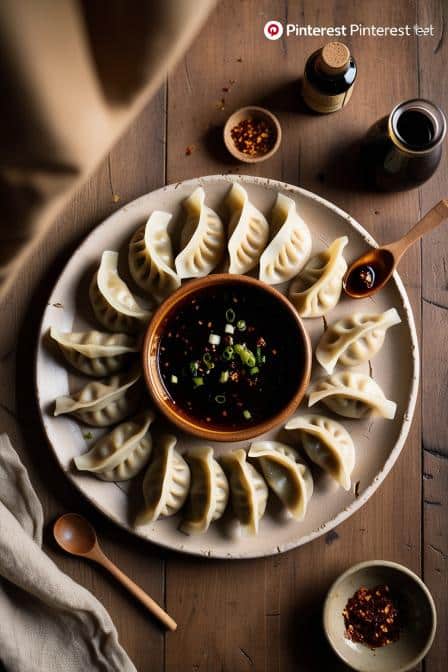The first time I burned my tongue on a dumpling, I was 14. Too eager, too hungry, too mesmerized by that glistening, sesame-speckled sauce on the side. That moment stuck with me—not just the sting, but the flavor. It was salty, sweet, tangy, with a whisper of heat and umami that made everything else on the plate feel like a sideshow. That was the day I realized dumpling sauce isn’t just a dip—it’s a revelation.
Dumpling sauces are not universal. Walk into any home in Sichuan, Seoul, or Tokyo, and you’ll find a wildly different idea of what a dumpling should swim in. That’s what makes them magical. They’re adaptable. Personal. And when you get the right balance? It turns even the humblest freezer-aisle dumpling into something unforgettable.
Today, I’ll walk you through an expert-level, no-fuss, highly customizable dumpling sauce that’s quick to whip up, layered in flavor, and utterly addictive. Think of it as your base blueprint—classic, but with room for wild spins.
What Makes This Dumpling Sauce Special?
This isn’t your packet-included, soy-heavy, bland pour-over.
This sauce hits five flavor zones—salty, sweet, sour, spicy, and umami—with punch and grace. It’s built around dark soy for depth, rice vinegar for zing, and a touch of chili crisp for crunch and heat. You can tweak it depending on your mood or the style of dumplings you’re working with.
It’s ready in 5 minutes. No cooking. No blenders. Just whisk, taste, tweak.
Let’s get into it.
Ingredients & Substitutions
The magic lies in quality balance. But that don’t mean you gotta hunt down rare imports. Most ingredients are pantry staples, or easily swapped for what’s on-hand.
Here’s the base formula:
| Ingredient | Purpose | Substitution | Pro Tip |
|---|---|---|---|
| Soy Sauce (Light) | Salty base | Tamari or Coconut Aminos (GF) | Use naturally brewed soy for depth |
| Dark Soy Sauce | Color + caramel flavor | Omit if unavailable | Just a splash transforms color |
| Rice Vinegar | Bright acidity | Apple cider or white vinegar | Unseasoned rice vinegar is best |
| Sesame Oil | Nutty, toasty richness | Toasted walnut oil | Don’t skip this—it’s key for aroma |
| Garlic (grated/minced) | Pungency + bite | Garlic powder in a pinch | Smash to release oil before mincing |
| Fresh Ginger (grated) | Zingy heat | Ground ginger (½ amount) | Fresh gives more floral punch |
| Chili Crisp or Chili Oil | Heat + crunch | Red pepper flakes in sesame oil | Lao Gan Ma is a go-to in pro kitchens |
| Sugar (brown or white) | Balance | Honey or maple syrup | Brown sugar gives richer base |
| Scallions (thinly sliced) | Freshness | Chives or omit | Add at the end to keep vibrant |
| Optional: Shaoxing Wine | Depth + aroma | Dry sherry or omit | Adds old-school Chinese warmth |
If you want to go extra umami, stir in a dash of fish sauce or a few drops of black vinegar—both bring earthiness.
Wanna go vegan? Easy—just skip the fish sauce. Gluten-free? Use tamari and check your chili crisp ingredients.
Step-by-Step Instructions
No stove, no stress. Just follow this order and you’ll get peak flavor every time.
Step 1: Mix the Base
In a bowl, add:
- 2 tablespoons light soy sauce
- 1 tablespoon dark soy sauce
- 1 tablespoon rice vinegar
- ½ teaspoon sesame oil
- ½ teaspoon brown sugar
Whisk till the sugar dissolves. This is your core. Everything else builds on this.
👉 Pro tip: Warm the bowl for 10 seconds in the microwave. Helps sugar dissolve faster and brings out aroma.
Step 2: Add Aromatics
Now stir in:
- 1 small garlic clove, minced or grated
- ½ teaspoon fresh ginger
- 1 tablespoon chili crisp (with oil and solids)
Let this sit for 2–3 minutes. Let the heat from the garlic and ginger infuse the sauce.
👉 Avoid this mistake: Adding garlic chunks too big. They overpower bites. Always mince fine.
Step 3: Final Touches
Stir in:
- 1 tablespoon chopped scallions
- Optional: ½ teaspoon Shaoxing wine
- Optional: dash of black vinegar or fish sauce
Taste it. Want more heat? Add more chili oil. Too salty? Drop in a bit more vinegar or water.
Boom. That’s it.
Variations
- Spicy-Sweet: Add a squirt of sriracha and a teaspoon of honey
- Sour-Kick: Use extra vinegar + a few pickled chilies
- Creamy Fusion: Whisk in a spoonful of tahini or peanut butter for a nutty Korean-Chinese twist
Cooking Techniques & Flavor Science
Why This Works
You’re playing with flavor balance. Soy sauce gives umami and salt. Vinegar cuts richness. Sugar smooths the harsh notes. Ginger and garlic punch through everything else. Chili crisp? It’s not just heat—it’s texture, aroma, and surprise.
It’s layered.
Think of this as an emulsion of contrasts—not unlike vinaigrette for dumplings. You want sweet clashing gently with sour. Heat teasing through oil. Each bite should taste a little different from the last.
The Science Behind It
- Soy sauce is fermented—it’s packed with glutamates (umami), which latch onto your tongue’s fifth taste receptor. That’s why it feels satisfying.
- Vinegar’s acetic acid cleans the palate, making each dumpling taste fresh.
- Chili oil contains capsaicin, which stimulates heat receptors—waking up other flavors.
- Sugar activates the Maillard-compound notes in garlic and soy, bringing out toasted undertones.
Each element has a job. This ain’t just throwing random things in a bowl.
Tools Matter Too
Use a ceramic or glass bowl, not metal. Metal reacts with vinegar, dulls flavor.
Whisk with a fork or chopsticks—spoons can’t blend oils well. If storing, use a glass jar with tight lid.
Storing & Reheating
Make a big batch. This sauce keeps well.
- Fridge: Store in airtight glass jar, up to 10 days.
- Freezer: Not ideal. Garlic flavor dulls when frozen.
- To use again: Let sit at room temp 10 mins. Stir well before using. Add fresh scallions last-minute for brightness.
Pro trick: Add a splash of water before refrigerating—it mellows out overnight intensification.
Serving & Pairing Suggestions
You can dunk, drizzle, or toss.
Best With:
- Pan-fried gyoza
- Steamed shrimp shumai
- Pork xiao long bao (soup dumplings)
- Korean mandu
- Even potstickers from the freezer aisle
Creative Ideas:
- Use it as a noodle dressing—toss with cold soba or rice noodles
- Drizzle over crispy tofu or grilled eggplant
- Spoon on sticky rice bowls with shredded chicken
- Mix with mayo for a dumpling dipping aioli
Garnish with toasted sesame seeds, extra scallions, or a fresh chili slice for drama.
Use wide, shallow bowls when serving dumplings and drizzle sauce across instead of dipping—it looks sexier and each dumpling gets a taste.
Best Time to Serve
Honestly? Anytime.
But this sauce sings brightest fresh out of the fridge, poured over hot dumplings, when that temperature contrast hits.
It’s a showstopper at:
- Weeknight dinners
- Potlucks (make it in a jar, bring along)
- Dumpling parties (DIY dipping stations)
- Lazy Sundays (over leftover rice with a fried egg—trust me)
Late-night snack with a cold beer? Yeah. It holds up.
Conclusion
This quick dumpling sauce isn’t just a condiment—it’s a flavor bomb in a bowl.
It takes less than 5 minutes. No cooking. Just some good soy, fresh ginger, a spoonful of chili crunch, and boom—you’ve got something that makes store-bought dumplings feel like handmade heaven.
You’ve now got a blueprint that’s flexible. Spice it up, mellow it down, make it vegan, gluten-free, sweet, tangy, nutty, or fiery.
Final tip? Make extra. Always. You’ll end up using it for things you never planned.
FAQs
1. Can I make this dumpling sauce ahead of time?
Absolutely. It’s even better after an hour or two. Just skip adding scallions until ready to serve so they stay fresh and vibrant.
2. Is this sauce only for dumplings?
Not at all. It’s brilliant on noodles, rice bowls, tofu, roasted veggies—even grilled meats.
3. What if I don’t have chili crisp?
Use plain chili oil or mix red pepper flakes with sesame oil. You can even warm oil and steep it with garlic + chili flakes for DIY chili oil.
4. How do I adjust it for kids or those who don’t like spice?
Just skip the chili crisp and reduce raw garlic. You can add a tiny bit of ketchup or hoisin for a sweet-salty profile they’ll love.
5. Is this sauce gluten-free?
Yes, if you use gluten-free tamari or certified GF soy sauce. Always check labels on chili oil too, just to be safe.
Let your dumplings take a bath in something worth remembering. This sauce ain’t just tasty—it’s unforgettable.

